By: Peter Romaskiewicz [Last Update: June 2020]
Introduction: Within a decade after the Kamakura Daibutsu was “discovered” by foreign travelers in the 1860s, it emerged as a requisite tourist destination for globetrotters hoping to document their trips to exotic, picturesque locals. Photographic images taken by professional studios and amateur photographers soon started to circulate and by the first few decades of the twentieth century the imagery of the Daibutsu began to have a significant impact on American consciousness. Many thousands of photographs were taken of the Kamakura colossus between 1860 and 1930, but reliably dating many of these images remains a difficult task. It is my hope to provide a few suggestions on criteria which can be used to determine the relative age of old photographs of the Kamakura Daibutsu. I am primarily interested in determining the time the photograph was taken, not when it was printed or published, a subsequent event that could happen at a considerably later date. An extraordinarily helpful resource has been the Metadata Database of Japanese Old Photographs In Bakmatsu-Meiji Period, hosted by the Nagasaki University Library. Several of the items below are part of my personal Archive.
Dating and Attributions: Precisely dating the photographs of many professional Yokohama studios can be difficult. The main means of determining the age of a photograph involves dating the album into which it was collated. Many title pages of old tourist albums did not include publication dates, thus other information – such as the named partners of the firm or the address of the studio, among other details – need to be compared with known facts to best ascertain its age. Sometimes the owner of the album inscribed the book with a date, thus helping to determine an album’s possible age. This is not without its own difficulties. New studios would buy (or pirate) the negative stock of older studios, and thus certain photos may be reproduced for decades after they were first taken. Thus, knowing the publication date of a photo only provides a terminus ante quem, which may or may not be closely related to the date of its original creation. In addition, unless we are privy to the travel schedules of professional photographers in Japan (or Yokohama specifically), we may only know the period of a photo’s creation to the span of several years. In some cases, the dating of amateur tourist photography, more common by the late 1880’s, can be more precise. Sometimes published travelogues or information gleaned by accounts written in newspapers can give information regarding the season or even the month or day an intrepid photographer visited a site. I will utilize all of these methods to establish a framework of absolute dates, which will be interspersed with additional photos based on relative dating and sequencing. I can only hope this may assist in determining the creators of several studio albumen and silver-gelatin prints which now remain anonymous or contested.
Executive Summary: The easiest way to loosely estimate the age of the image-capture of the photograph (not necessarily its printing or publication), it to examine the coin donation box (saisen–bako 賽銭箱) directly in front of the offering table. In the oldest photos, the donation box starts off as an unadorned, mid-thigh height wooden box. A terminus post quem for the summer of 1877 can be established for the small gabled roof attached to the top of the box. In addition, a terminus post quem of November 1890 can be established for the picketed fence surrounding the box. In the early twentieth century, the arrangement of the lotus flowers on the offering table are the best means for estimating a date. Even more precise methods for estimating age are discussed below. The basic abbreviations are as follows:
- TAQ: terminus ante quem [the photograph was taken before this date]
- TPQ: terminus post quem [the photograph was taken after this date]
Contact: Please contact me (Peter) should you wish to offer any thoughts or insights, it will be much appreciated! Email: pmr01(AT)ucsb(DOT)edu. _/|\_
Sequential Chronology: 01
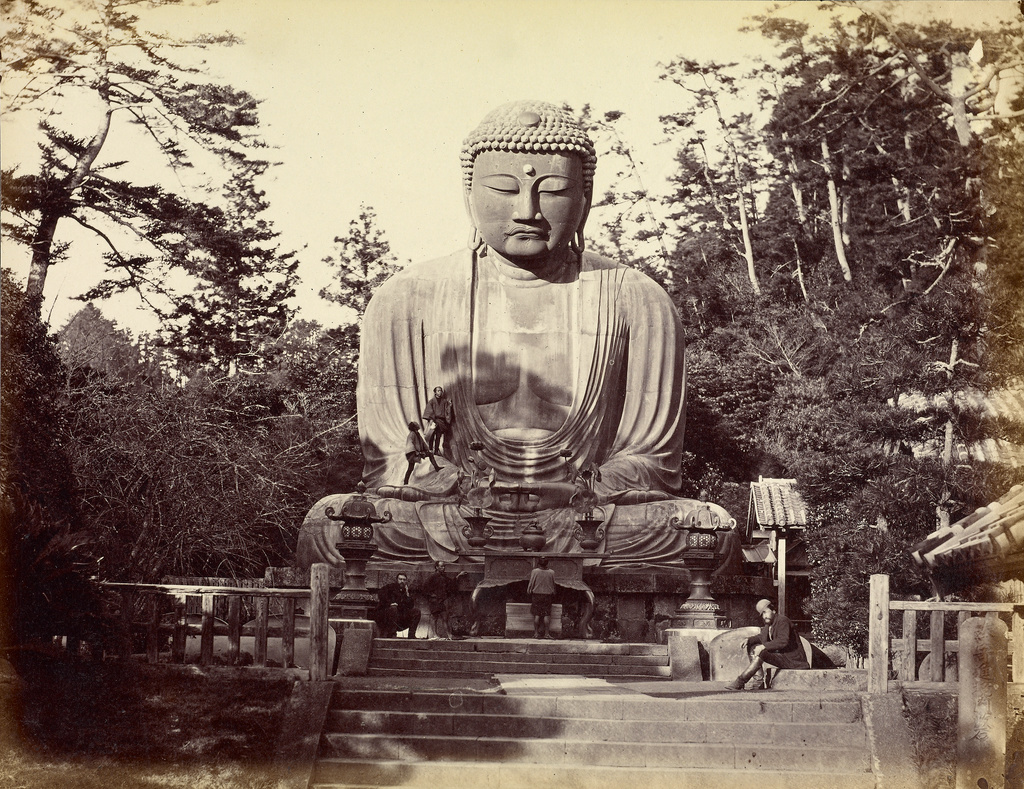
- Date: c. 1863, TAQ: 1865
- Information: Found in albums sold by Felice Beato (1832-1909) before his studio fire in 1866, this image is often dated to 1863 when Beato first arrived in Yokohama and toured with the Swiss diplomat Aimé Humbert. Some prints are dated to January 1865 and a full-page engraving of this photo was published in the Illustrated Times on October 28, 1865, establishing a firm terminus ante quem. Humbert’s account was first published in 1866 and included an engraving of this photograph. It has been suggested that Beato is the man sitting on the left (Bennett 1996: 140). [A similar framing, without people, can be found here and here, with the last inscribed with the date 1864.]
- Description: Large cast metal lotus petals sit as the base of the first landing which are partly obscured by a railing erected at the front end of the second landing. Fronds of a Japanese sago palm are visible at the left in front of the railing.
Sequential Chronology: 02
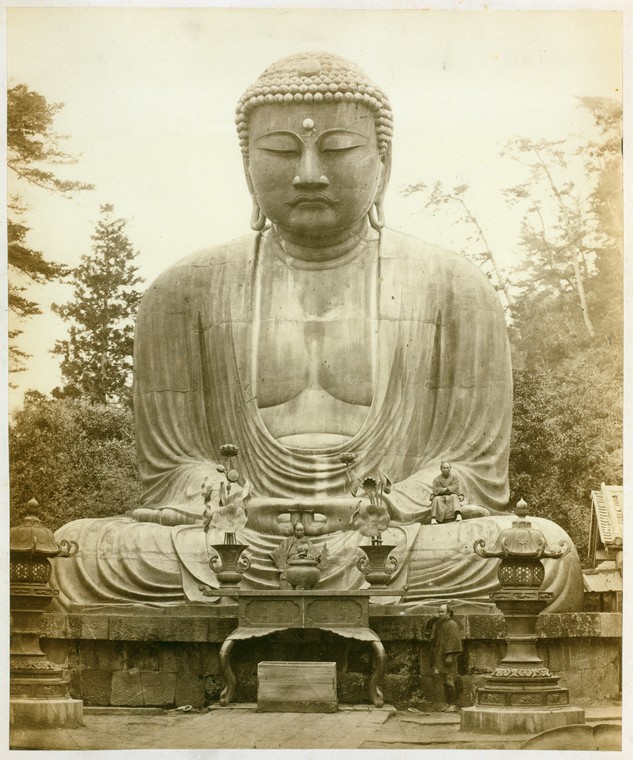
- Date: c. 1868
- Information: After the great Yokohama fire destroyed Beato’s studio in 1866, this photograph was part of the new negative stock made between 1867-1868 and sold to tourists at his new studio. This image is often dated to 1868.
- Description: Here we see a clear view of the coin box in front of the offering table and the long, curled finials atop the metal lanterns. Also note the distinctive placement of the metal lotus flowers in the urn atop the offering table, especially the bend in the stem on the right-side flower. It is possible to see the tip of the large cast metal lotus petal in the lower right.
Sequential Chronology: 03
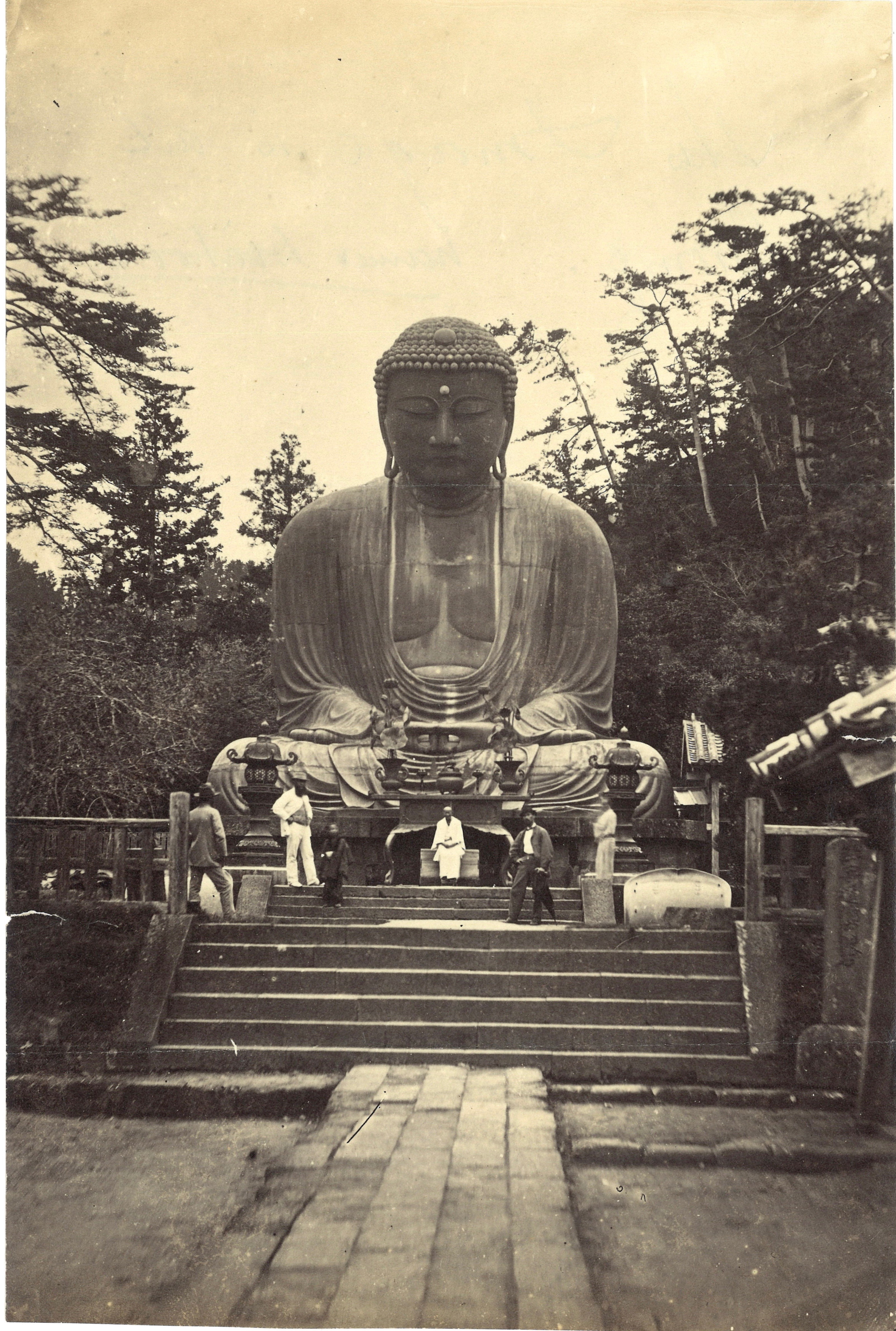
- Date: TAQ: 1870
- Information: The National Library of New Zealand holds the same image. In that collection, the photograph is described as part of an “album of photographs compiled on cruises aboard HMS Endymion with the Flying Squadron,” which made an around-the-world voyage in 1969-70, landing in Japan in April 1870. The National Library dates this image between 1867-9 and suggests Beato as photographer, but this is likely incorrect. I have seen this image in Wilhelm Burger’s (1844-1920) A Series of 56 Views of Towns, Villages, etc. in Japan, published in 1871 (for more on Burger, see below). This would date the image to 1869-1870.
- Description: Same as above but two small altar implements have been added between the pair of flower urns and the central incense burner.
Sequential Chronology: 04
- Date: c. 1870; TAQ: May 30, 1870
- Information: John Reddie Black (1826/7-1880) published the first issue of The Far East: A Monthly Illustrated Journal at the end of May 1870 and included a photograph of the Daibutsu. No photo credit is provided in the publication, but the same image is attributed to Wilhelm Burger (1844-1920), who traveled in Japan from the Fall of 1869 to the Spring of 1870. It is possible that Burger’s negative came to Black through Michael Moser, Burger’s photographic assistant who became the staff photographer at the Far East (see Bennett 1996: 37 & 2006b: 90-1).
- Description: The railing on the left has been removed, but the railing on the right remains intact. Other photographs attributed to Burger still show the left-side railing standing, however, suggesting its removal occurred during his travels in Japan. One Daibutsu photograph in a Burger album held by the British Museum, entitled A Series of 56 Views of Towns, Villages, etc. in Japan, depicts the left handrail as displaced and balusters tilted. One anonymous photograph depicts the damaged balusters of the left railing.
Sequential Chronology: 05

- Date: TAQ: 1873
- Information: This carte de visite print is attributed to Shimooka Renjo 下岡蓮杖 (1823-1914) in the Freer-Sackler Gallery archives. The reverse of the card indicates it was printed in 1873, providing a (presumably) reliable terminus ante quem. The photo was reproduced in Thomas Woodbine Hinchliff’s Over the Sea and Far Away in 1876. The image above was analyzed for the Visual Literacy of Buddhism series here.
- Description: It is difficult to determine, but it appears the newel post of the railing atop the third landing on the right still remains. The railing on the left is clearly missing. The base of the stone marker at the bottom of the second landing noting the donation of the paving stones is also visible.
Sequential Chronology: 06

- Date: TPQ: 1870; TAQ: 1877
- Information: From the studio of Baron Raimund von Stillfried-Ratenicz (1839-1911), this image was sold as part of an album entitled Views and Costumes of Japan at the State Library of Victoria, which dates roughly to 1876, after the move of the Anderson & Stillfried studio in late 1875 and before the studio fire of January 1877. Stillfried opened his Yokohama studio in August 1871 and apprenticed in Beato’s Yokohama photography studio starting in 1870 (Bennet 2006a: 309).
- Description: The railing on both sides atop the third landing has disappeared, but large cast metal lotus petals remain at the base of the second landing. The coin box is unadorned, the lamps have long finials, and the urns atop the offering table still hold metal lotus flowers.
Sequential Chronology: 07
- Date: TPQ: 1870; TAQ: 1877
- Information: The photographer is unknown.
- Description: This image is important because it shows the damaged structure to the right of the Daibutsu (the same damaged structures is seen in another picture in the Archive). The roof here slopes north-south, and the new building has an east-west sloping roof.
Sequential Chronology: 08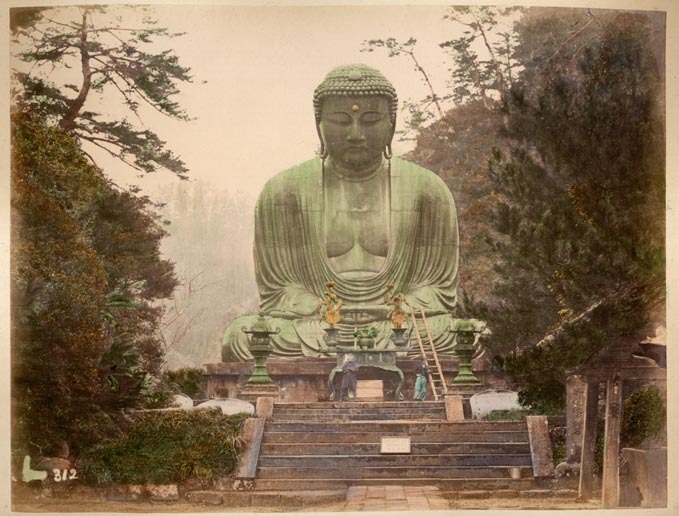
- Date: TPQ: 1870, TAQ: 1877
- Information: Attributed to Suzuki Shin’ichi (II) 鈴木 真一 (1855–1912), this image is found at the Musée Guimet (see also Bennett 2006b: 149). Suzuki’s father was also an outstanding photographer.
- Description: It shows the overgrown temple grounds surrounding the Daibutsu before the major landscaping renovation. The long ladder is also featured in several other photos from this period. The small sign on the steps, placed there by Suzuki, reads: “Daibutsu Kamakura 仏大倉鎌.” The large cast metal petals at the base of the first landing are moved slightly from their original positions.
Sequential Chronology: 09
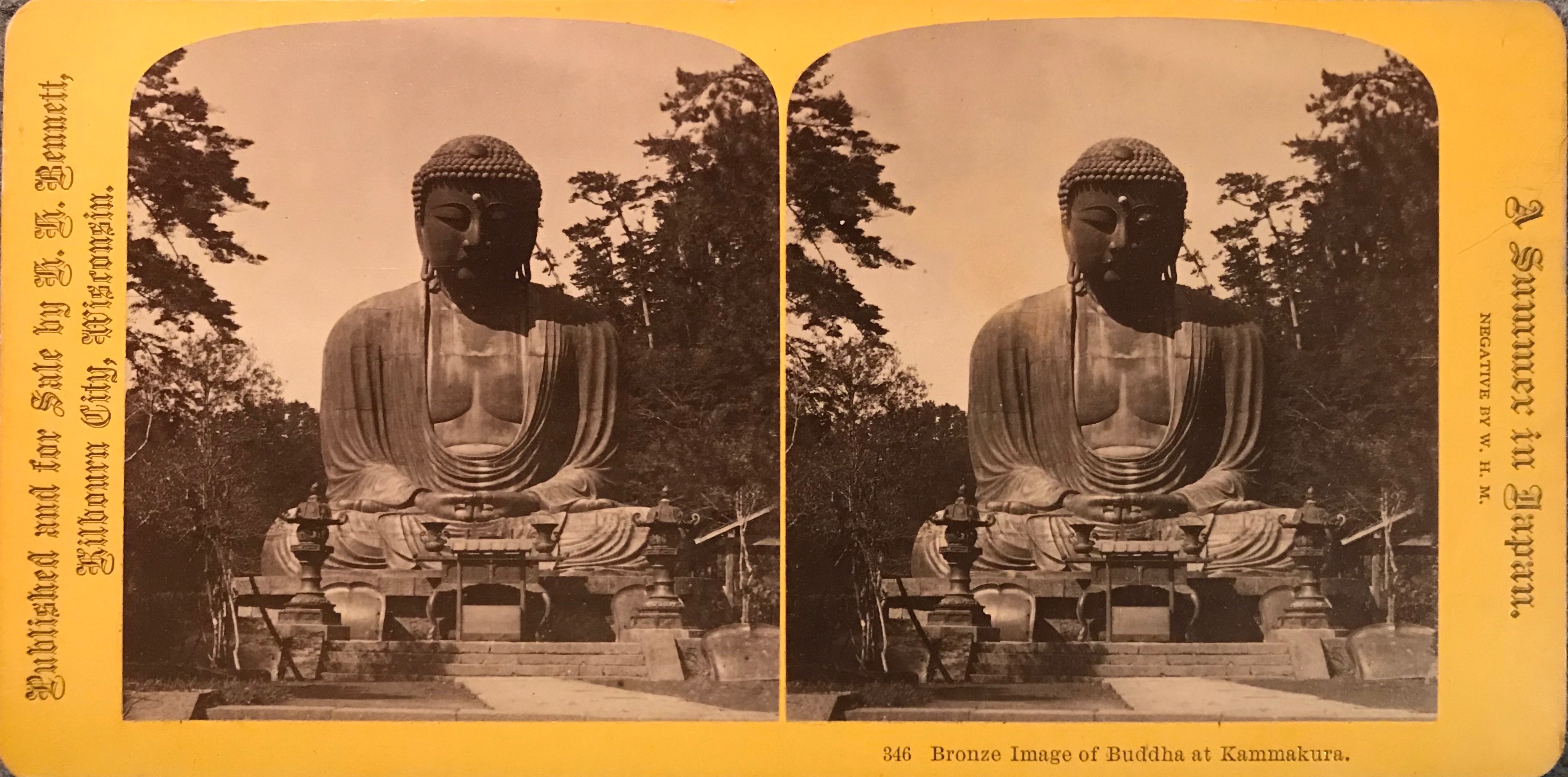
- Date: Summer 1877
- Information: William Henry Metcalf (1821-1892), arriving in Yokohama in June 1877 with the pioneering “Japanologist” Edward Sylvester Morse (1838-1925), set out on a four-month tour photographing the Japanese landscape. The image above was analyzed for the Visual Literacy of Buddhism series here.
- Description: This image gives a definitive terminus ante quem for the small gabled roof atop the coin box and the removal of the metal lotus flowers from the urn on the offering table. It also shows that two large cast metal lotus petals were moved to rest against the pedestal of the Daibutsu before being removed altogether. The lamps still retain their long, curling finials. The new gabled roof structure can be seen to the right of the Daibutsu.
Sequential Chronology: 10
- Date: TPQ: 1877; TAQ: 1879/80
- Information: From the studio of Baron Franz von Stillfried-Ratenicz (1837-1916), this image at the Edinburgh Library (also numbered 351) was incorporated into a tourist volume entitled Views and Costumes of China & Japan, which dates from between 1879-1883. Franz (not to be confused with his brother, Raimund) opened his photography firm in 1879 (at 80 Main Street, as noted on the cover page), but he received negatives from his brother, Raimund, who previously owned a studio in Yokohama (Bennett 2006a: 139-40, 154). It remains undetermined who took this photograph.
- Description: This image is important because it depicts a groomed temple landscape just previous to the major renovation project. The large cast metal lotus petals have been removed and replaced by small shrubs at the base of the first landing. The grass at the base second landing has been cut and the sago palm is more easily identifiable on the left. This image also shows that the metals lotuses atop the offering table remain missing. Additionally, the spiral finials on the lamps were removed before other signs of renovation work appeared. The stone marker at the base of the second landing noting the donation of the paving stones has also been removed.
NOTE: The sequence of photographs depicting temple renovation through 1896 remains highly conjectural. There are numerous small adjustments made in the landscaping and altar design, thus making it difficult to determine a precise chronology.
Sequential Chronology: 11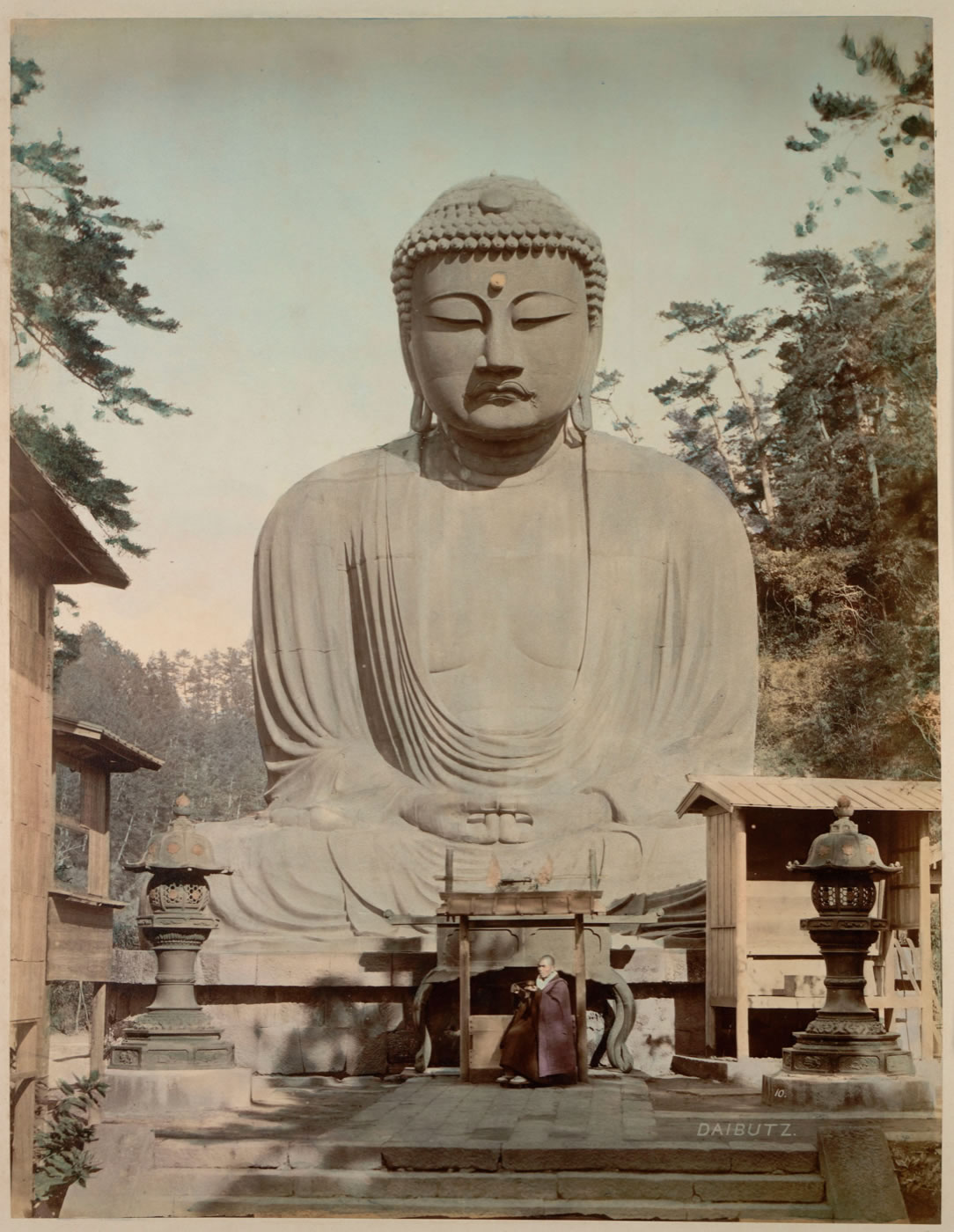
- Date: c. 1879; TAQ: 1880
- Information: From the studio of Baron Raimund von Stillfried-Ratenicz (1839-1911), this image was taken from Views and Costumes of Japan at the Musée Guimet, which dates from 1877-1880. (A similar image depicting the same priest can be found here and here).
- Description: Showing clear evidence of the renovation process, the urns holding the metal lotuses have also been removed altogether. It is claimed that construction lasted from 1877-1887, with donor name signboards (on the left above) appearing since 1879. A wider view of the renovation project can be seen here.
Sequential Chronology: 12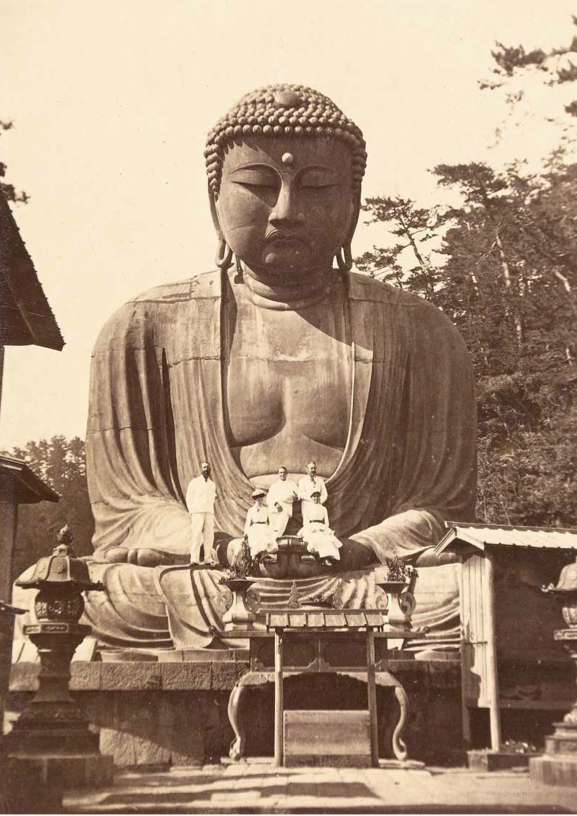
- Date: July 1882
- Information: This image depicts the British globetrotter Francis Guillemard and his excursion party at the Kamakura Daibutsu. It may have been taken by Usui Shūzaburō 井秀三郎 (fl. 1867-1884), who was commissioned to take photographs during part of Guillemard’s trip (photo and information from Bennet 2006a: 226).
- Description: This image shows plants placed in the urns atop the offering table and roof tiles in the structure at the left knee of the Daibutsu. Presumably, these tiles were used to roof the structure to the immediate right of the statue.
Sequential Chronology: 13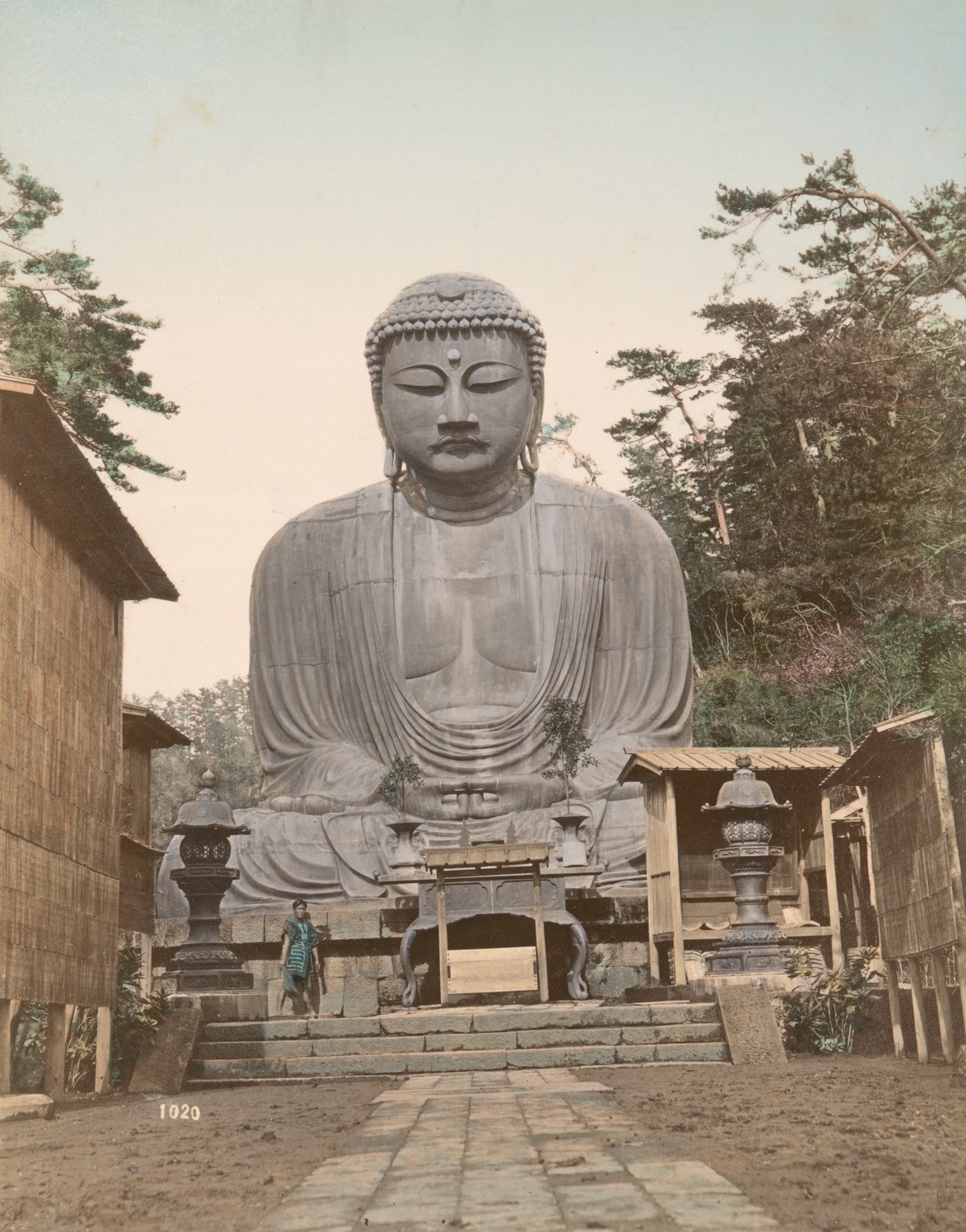
- Date: c. 1882
- Information: Attributed to Kusakabe Kimbei 日下部金兵衛 (1841-1934), but sold in several studio albums. (Cf. Bennett 2006b: 140)
- Description: This image is very similar to the Guillemard photograph above, but the plants in the urns on the altar are different.
Sequential Chronology: 14

- Date: c. 1887
- Information: Often attributed to Adolfo Farsari (1841-1898), this image, taken from an album entitled Photographs Relating to Japan, is commonly dated to after the fire at Farsari’s studio in 1886, and before he reopened his studio in 1887. (see also Bennett 2006b: 133). It was reprinted in William Caine’s A Trip Around the World in 1887-8, in 1888, thus providing a firm terminus ante quem for its printing.
- Description: This image defies some expectations and I am unsure of my assessment. In an earlier version of this chronology, I speculated that the photograph may have been previous to 1879/80, but I now think the evidence better aligns with the more traditional c. 1887 dating. The gabled roof on the coin box and the lack of metal lotuses in the urns clearly indicate it was post-c. 1877. The branches placed in the urns are in accord with what is seen during the renovation of the early 1880s (but also see Usui image noted below). Curiously, the fact that the structure on the right of the Daibutsu has a gabled roof (not a hip roof) suggests the new building was not even started before all other signs of renovation were cleared away. In fact, it has been suggested the roofing tiles (for the new structure) can be seen piled up behind the offering table. The small shrubs at the base of the first landing may have been natural growth during the renovations (see previous image). Finally, the rather sturdy looking five-step ladder continues to be present for a while after the renovation. Part of my lack of confidence stems from a comparable photo attributed to Usui Shūzaburō 井秀三郎 (fl. 1867-1884) – but showing the lantern finials still attached. That image is definitively dated to c. 1877. In any regard, Farsari’s reputed image would have to post-date that, and considering my recent thoughts, that would be by about a decade.
Sequential Chronology: 15![1020 Daibutsu [Kimbei]](https://peterromaskiewicz.com/wp-content/uploads/2018/12/1020-Daibutsu-Kimbei.jpg)
- Date: TPQ: c. 1887; TAQ: November 1890
- Information: This photograph has been attributed to Tamamura Kōzaburō 玉村康三郎 (1856-1923?) and Kusakabe Kimbei 日下部金兵衛 (1841-1934)[for Kusakabe attribution see comments section here]. (Cf. Bennett 2006b: 140)
- Description: This image shows a curious structure next to the Daibutsu, presumably a temporary structure before the hipped roof building was erected. Importantly, the metal lotus flowers have been placed back into the urns atop the offering table (note the slightly different arrangement from earlier), in positions they will remain for the next two decades. The foliage creeping in from the right of the frame suggests the row of evergreens are cropped out of this photograph (see next image).
Sequential Chronology: 16![536 Daibutsu at Kamakura [National Gallery of Victoria, Melbourne]](https://peterromaskiewicz.com/wp-content/uploads/2018/12/536-Daibutsu-at-Kamakura-National-Gallery-of-Victoria-Melbourne.jpg)
- Date: TPQ:c. 1887; TAQ: November 1890
- Information: Three photographs regularly attributed to Tamamura Kōzaburō 玉村康三郎 (1856-1923?) are sequentially numbered 534, 535, and 536 (see Bennett 2006b: 152)[although Kimbei attributions exist]. These three photographs were taken on the same day (the small boy with the hat is seen in all three, here seen by the ladder on the pedestal)
- Description: Number 535 is taken from the closest distance, and number 534 is taken slightly further away, showing the skinny evergreens at the base of the first landing on the left and a row of evergreens running down the second landing on the right (it is possible these were planted behind the Daibutsu as seen in later photographs). Number 536, shown above, is taken from the furthest distance, on the third landing, and shows more of the landscaping. Importantly, it depicts a small tree in front of the sago palms at the base of the second landing. The metal lotus flowers have been placed back into the urns atop the offering table (note the slightly different arrangement from earlier photographs). One can get a glimpse of the new hipped roof on the structure to the right of the statue between the evergreens.
Sequential Chronology: 17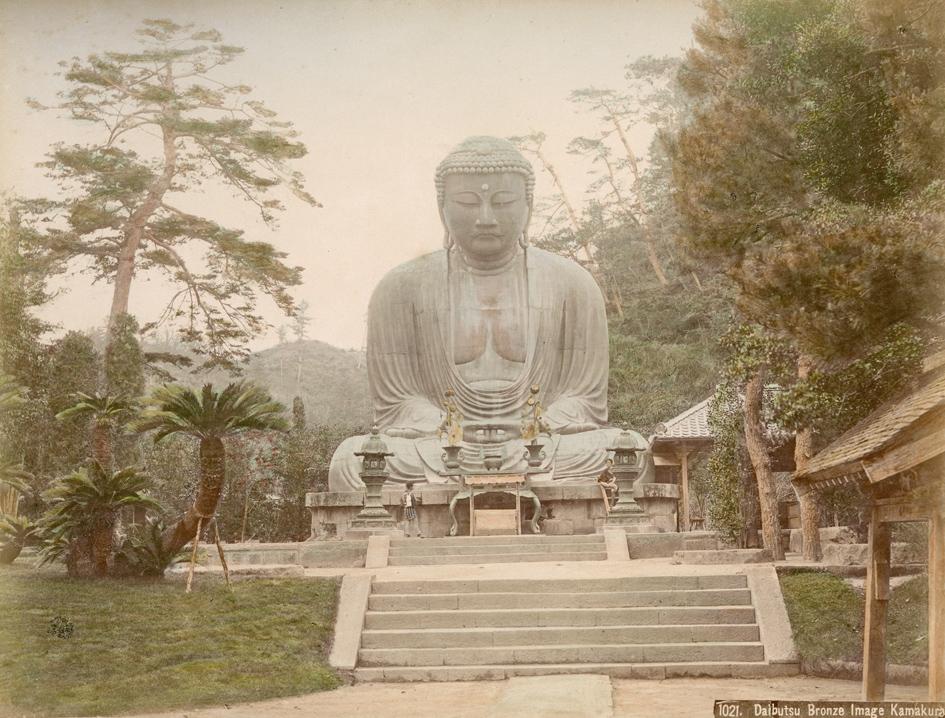
- Date: TPQ: c. 1887; TAQ: November 1890
- Information: Commonly attributed to Kusakabe Kimbei 日下部金兵衛 (1841-1934). (Cf. Bennett 2006b: 140)
- Description: This image shows a more barren landscaping design, with the evergreens removed from the second landing and the tree removed from in front of the sago palms. Importantly, this landscaping was finished before the coin box was reconstructed and surrounded by a picketed fence. This photo clearly shows the new hip roof on the structure next to the Daibutsu, replacing the older gabled roof.
Sequential Chronology: 18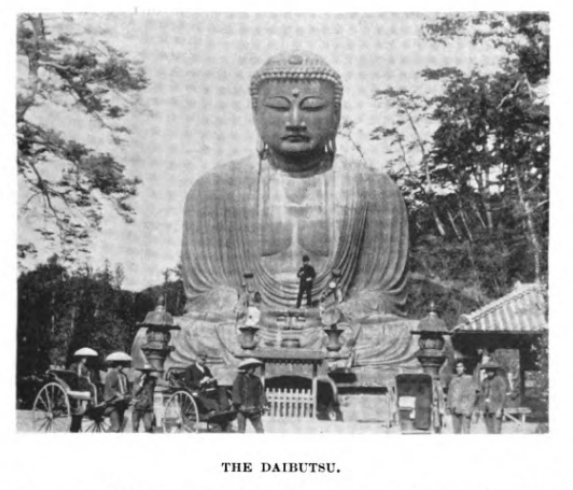
- Date: November 1890
- Information: Rev. Thomas Hobbs Stacy, armed with his Scovill camera rig, arrived in Yokohama on November 9, 1890 after nineteen days crossing the Pacific Ocean on the Belgic of the Occidental and Oriental Steamship Company (often abbreviated as O&O). Stacy does not inform us exactly when he visited Kamakura, but it was certainly in November, since by the middle of the month he was already setting sail to Kobe. He took the trip to the Daibutsu with his American travelling companion, Rev. Frank Weston Sanford, who was photographed sitting in the rickshaw, and Rev. Philip Wilson Pitcher, a missionary returning to Amoy, who was standing in the lap of the statue. Stacy also notes the presence of a small photography studio to the right of the Daibutsu, where local photographers would take photos of visitors. This information is summarized from the accounts Stacy wrote for The Amateur Photographer in May 1892 and his self-authored In the Path of Light Around the World in 1895. Shots with rickshaws were common in this period, I believe they were furnished by an on-site photography studio who hoped to give the shot a more exotic, Japanese feel.
- Description: This image provides us with a reliable terminus ante quem for the fenced coin box positioned in front of the Daibutsu. (Of course, this fence could have been erected before 1890; notably, I have seen a photograph hand-dated to 1886 that does not show the picket fence.) Presumably, this is before the small shrubs were (re)planted at the base of the first landing since they are not seen in the foreground (see following photograph). Regrettably, not know if the outstretched sago palm has a dual-arm or single-arm support makes identifying the sequence for the next few photographs difficult.
Sequential Chronology: 19![A87 Daibutsu at Kamakura [Bennett 2006 158 Unknown (2)].JPG](https://peterromaskiewicz.com/wp-content/uploads/2018/12/A87-Daibutsu-at-Kamakura-Bennett-2006-158-Unknown-2.jpg)
- Date: TPQ: November 1890?; TAQ: Spring 1896
- Information: Sometimes attributed to Ogawa Kazumasa 小川 一眞 (1860-1929). (Cf. Bennett 2006b: 158)
- Description: This image shows a row of small shrubs planted at the base of the first landing. replacing the young evergreens which were planted after the renovation. A dual-arm brace still supports the outstretched sago palm in the foreground. A small sign-board is also attached to the column of the building. It is possible this image was taken before Stacy’s photograph in November 1890 if the shrubs were planted and removed by the time of Stacy’s photograph. I cannot tell definitively if this was taken before or after the next photograph.
Sequential Chronology: 20![D25 Daibutsu, Kamakura [Kimbei][pring in photo!].JPG](https://peterromaskiewicz.com/wp-content/uploads/2018/12/D25-Daibutsu-Kamakura-Kimbeipring-in-photo.jpg)
- Date: TPQ: November 1890?; TAQ: Spring 1896
- Information: Sometimes attributed to Kusakabe Kimbei 日下部金兵衛 (1841-1934). (Cf. Bennett 2006b: 159)
- Description: This image shows a closer view of the Daibutsu with the shrubs in the foreground at the base of the landing. It is possible this image was taken before Stacy’s photograph in November 1890 if the shrubs were planted and removed by the time of Stacy’s photograph. I cannot tell definitively if this was taken before or after the previous photograph.
Sequential Chronology: 21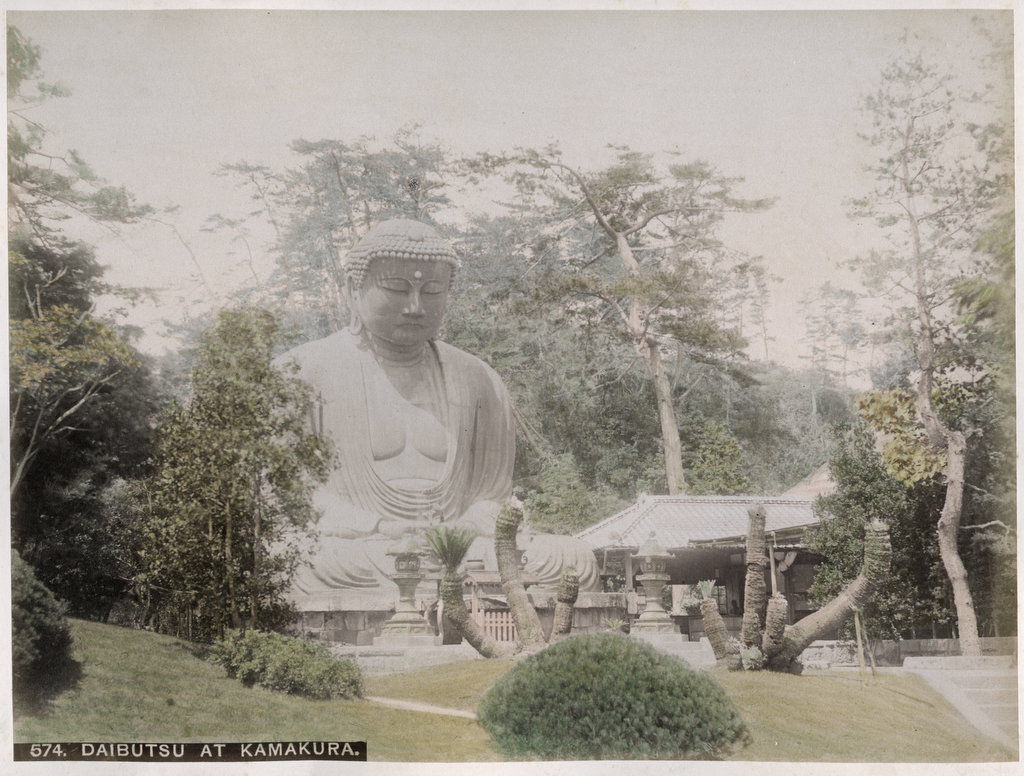
- Date: TPQ: November 1890; TAQ 1894
- Information: This photo is unattributed, but possibly belongs to Enami Nobukuni 江南 信國 (1859-1929) who has other shots from a similar angle. This photograph is published in Jame Clark’s Story of China and Japan, published in 1894, establishing a firm terminus ante quem.
- Description: This image shows an unusual vantage point from the southwest corner. Importantly, it depicts the sago palms without their fronds (possibly from a cold-weather spell?). The outstretched palm at the base of the second landing is still upheld by a dual-arm brace. It appears the rows of shrubs at the base of the first landing have been removed?
Sequential Chronology: 22
![41 Daibutsu Kamakura [Bennett 2006 125 - T Enami (2)] copy.jpg](https://peterromaskiewicz.com/wp-content/uploads/2018/12/41-daibutsu-kamakura-bennett-2006-125-t-enami-2-copy.jpg)
- Date: TPQ: November 1890?; TAQ Spring 1896
- Information: Possibly attributable to Enami Nobukuni 江南 信國 (1859-1929) (see Bennet 2006a: 125).
- Description: This image shows the removal of the small shrubs at the base of the first landing and the barren sago palm (a see previous image). As with the previous image, this could be older than November 1890. Note there is a later photograph captioned with stock number 41.
Sequential Chronology: 23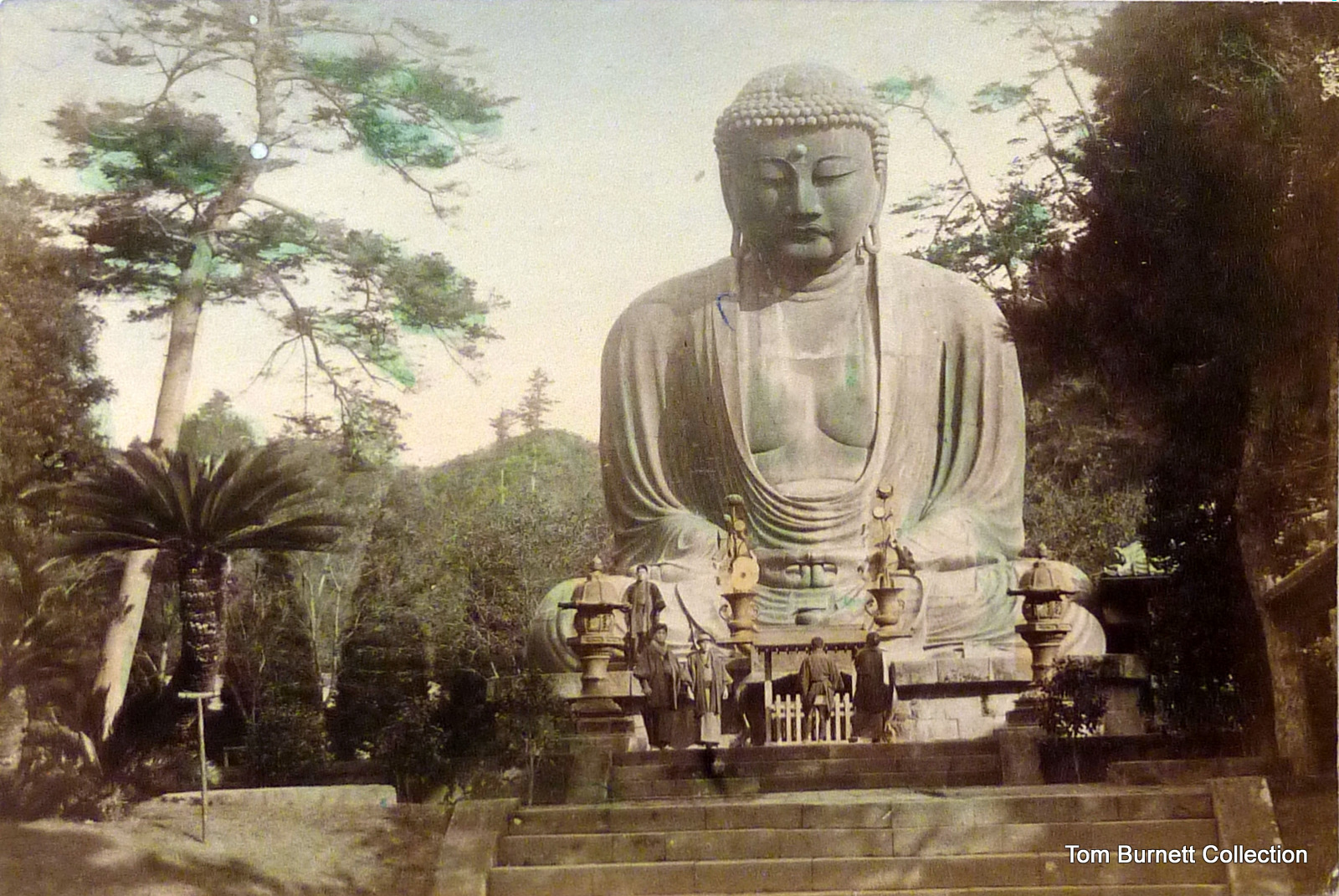
- Date: TPQ: November 1890?; TAQ Spring 1896
- Information: Attributed to Ogawa Kazumasa 小川 一眞 (1860-1929).
- Description: This image in the Tom Burnett collection shows a single-arm support bracing the outstretched sago palm (replacing the dual-arm support) with the small shrubs still planted at the base of the first landing. It is difficult to ascertain this photograph’s sequential position, it too could have been taken before Stacy’s image in November 1890 if the shrubs, clearly taller here than in the previous photographs, were removed before Stacy visited the Daibutsu. If this was the case, then the single-arm support was also present by that time.
Sequential Chronology: 24
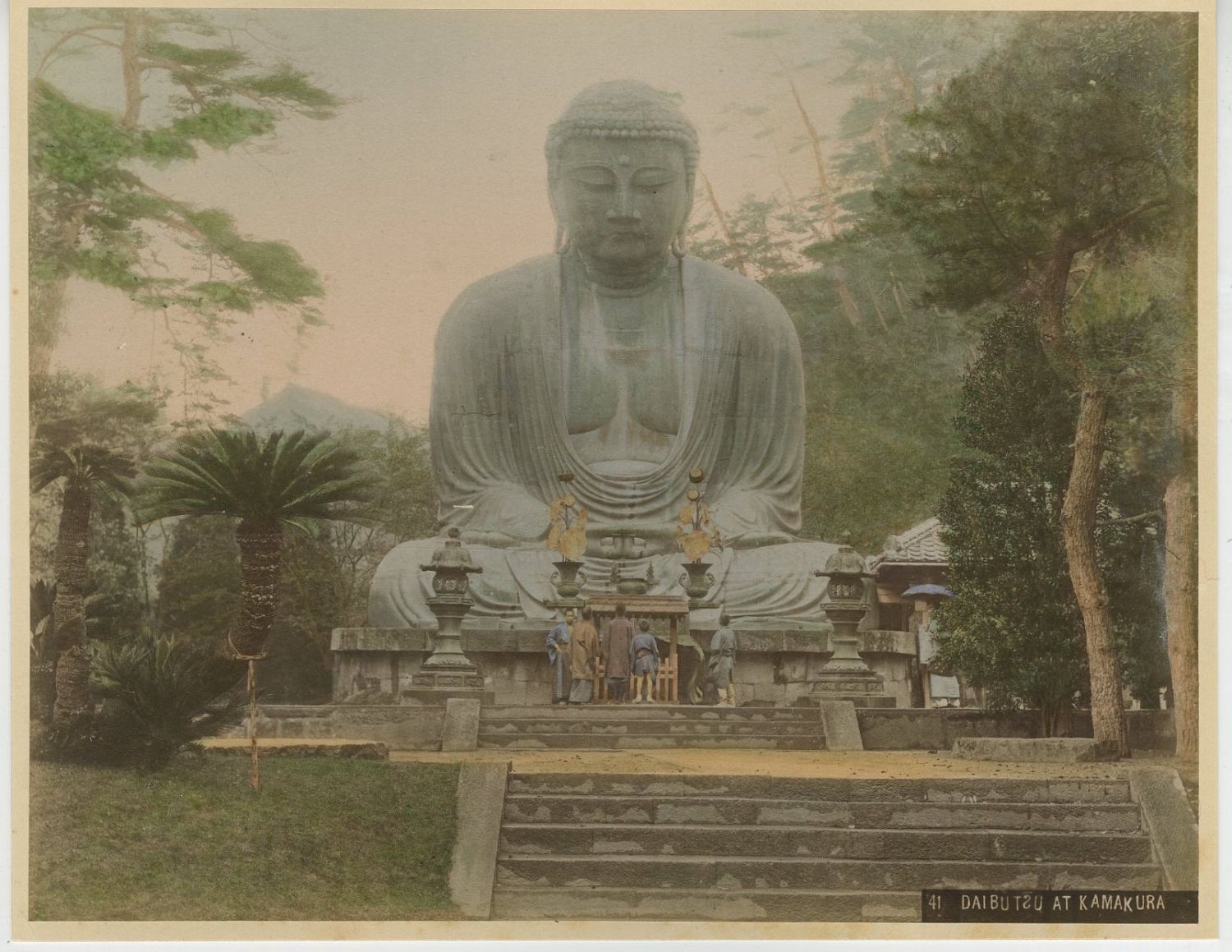
- Date: TPQ: November 1890?; TAQ Spring 1896
- Information: Possibly attributable to Enami Nobukuni 江南 信國 (1859-1929) (see Bennet 2006a: 125).
- Description: This image shows the removal of the small shrubs at the base of the first landing. As with the previous image, this could be older than November 1890. (A small detail in this image is the man holding an umbrella near the building and the step appear wet as well, indicating a rainy day. Stock photo 42 is also attributed to Enami, but it shows a sunny day.) Note there is an earlier photograph captioned with stock number 41.
Sequential Chronology: 25
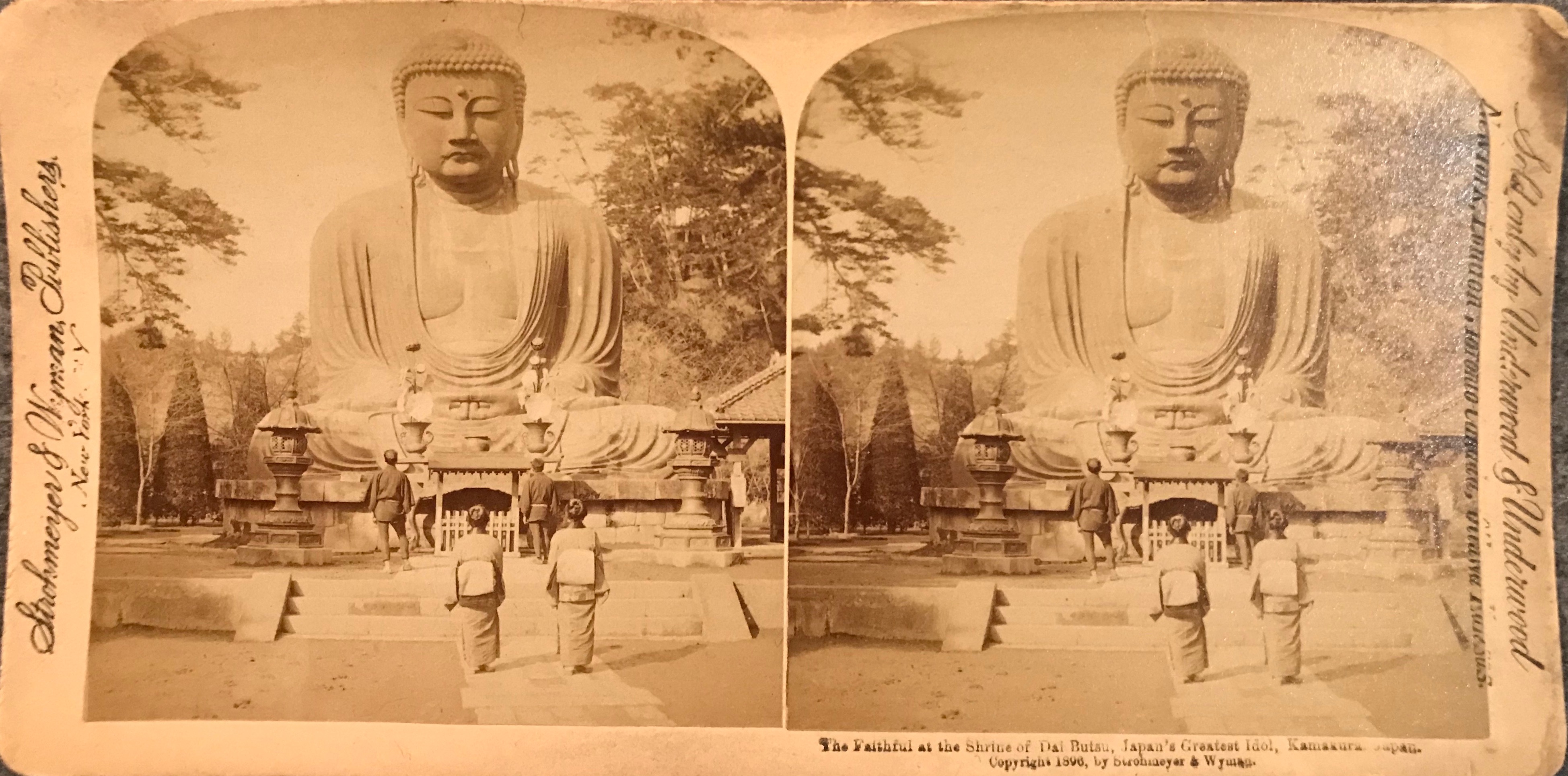
- Date: Spring 1896
- Information: Henry A. Strohmeyer (1858-1943) arrived in Japan in the Spring of 1896 to take a series of stereophotographs that would eventually comprise a 72-view set. The image above was analyzed for the Visual Literacy of Buddhism series here.
- Description: This is the first time a small placard is clearly visible resting by the right shin of the Daibutsu. Furthermore, a different stereocard from this set, including the same two pairs of Japanese men and women, takes a wider perspective of the landscaping and shows the outstretched sago palm is still upheld by a single-arm support. In both cards, the metal lotuses placed in the urns atop the offering table continue to face in opposite directions. This positioning of the lotuses (and small placard) remains in the first Keystone set (c. 1901) and the Stereoscopic Gems set and Universal set (both taken by Herbert Ponting late 1901 to early 1902). It is also found in the watercolor painting of Henry Roderick Newman (1843-1917), finished in 1898.
Sequential Chronology: 26

- Date: 1903
- Information: Returning to Japan to take photographs for Underwood & Underwood, Herbert Ponting traveled through Japan and its surroundings from Spring to Fall 1903. The image above was analyzed for the Visual Literacy of Buddhism series here.
- Description: This image is important because it clearly shows that both lotus flowers are now facing away from the Daibutsu. The small placard remains by the right shin of the Daibutsu.
Sequential Chronology: 27
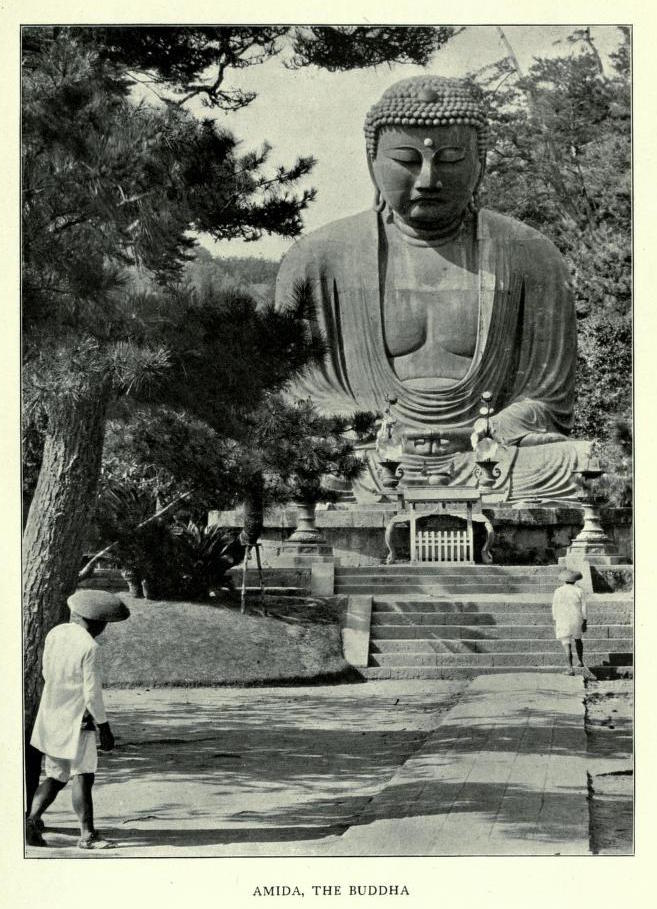
- Date: TPQ: 1903
- Information: Published in Herbert Ponting’s reminiscence of his travels in Japan in 1910, this image is certainly earlier.
- Description: It reveals that the single-arm support of the sago palm was replaced by a dual-arm support. There is also minor rain runoff damage by the stairs leading up to the second landing.
Sequential Chronology: 28
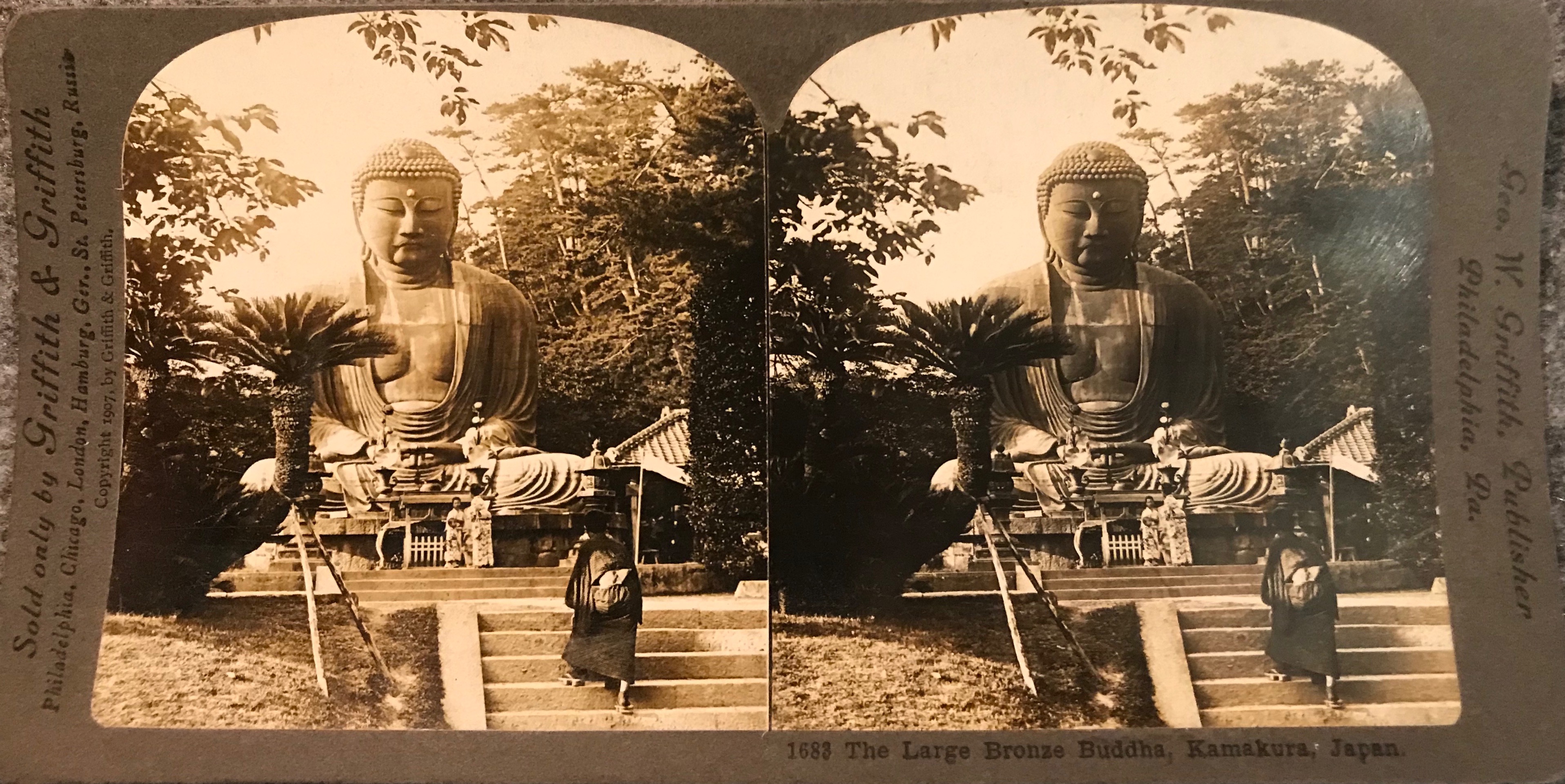
- Date: TPQ: 1903
- Information: The stereoscopic masterpiece by Enami Nobukuni 江南信國 (1859-1929) is analyzed here.
- Description: The outward turned lotus flowers prove this image was taken after 1903. This image also shows that the new dual-arm support for the sago palm was replaced by a sturdier dual-arm support. There is also minor rain runoff damage by the stairs leading up to the second landing.
Sequential Chronology: 29
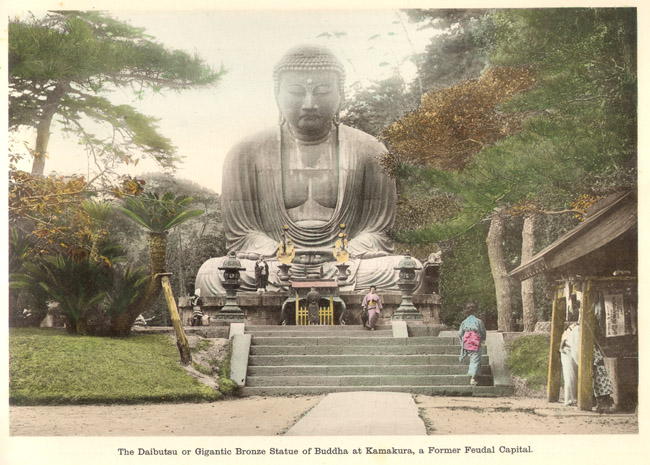
- Date: TAQ: 1910
- Information: Attributed to Ogawa Kazumasa 小川 一眞 (1860-1929) and published in his Sights and Scenes in Fair Japan first published in 1910. The second round-the-world cruise of the S.S. Cleveland landed in Japan in late February/early March 1910, and pictures of the Daibutsu published in the travelogue of William Frizell and George Greenfield depict a similar scene.
- Description: The brace of the sago palm has been reinforced by a large single log and there is significant rain runoff damage to the base of the second landing by the stairs.
Sequential Chronology: 30
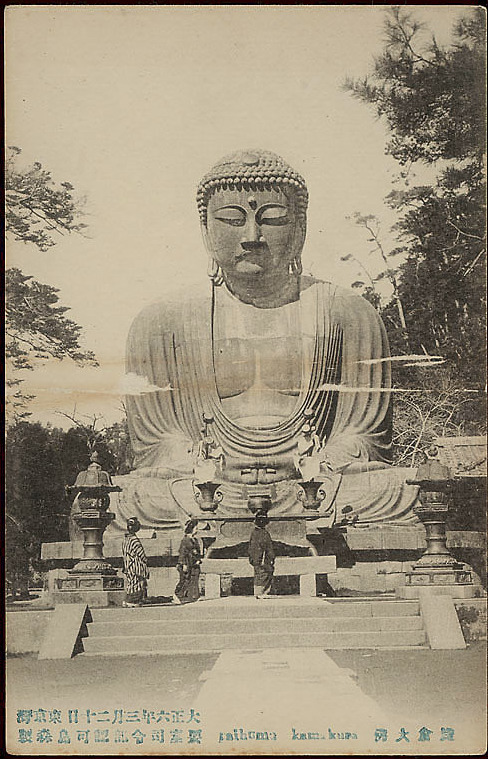
- Date: TAQ: 1917
- Information: The printed caption on this card is dated Taishō 6, or 1917. [A photograph in a private collection shows the picket fence still around the coin box in August 1912.]
- Description: A low waist-high stone bench or table has been placed in front of the offering table. Additionally, the picket fence and gabled roof coin box appear to have been replaced with a new box. The old hip-roof structure on the right of the statue has also been altered.
Sequential Chronology: 31
![1918 Pringle, James Maxwell [Library of Congress].jpg](https://peterromaskiewicz.com/wp-content/uploads/2018/12/1918-pringle-james-maxwell-library-of-congress.jpg)
- Date: 1918
- Information: James Maxwell Pringle took this photograph during his trip to Japan in 1918.
- Description: The two lotus flowers still remain on the offering table, but the one on the right appears to be facing more towards the west. The small placard remains by the right shin of the Daibutsu. The slab bench/table appears to have been removed. After the removal of the gabled-roof and picket fence around the coin box (after August 1912), and the removal of the slab bench, the altar arrangement is very similar to pre-1877 photographs. The positioning of the flowers can help determine the correct age.
Sequential Chronology: 32

- Date: December 6, 1919 [dated on obverse]
- Information: Unknown tourist photograph from Knights of Columbus.
- Description: The two lotus flowers still remain on the offering table, but at a different angle. It is difficult to know for certain, but the row of individuals immediately in front of the offering table is possibly on top of a low stone table or bench. In other photographs, the heads of people are typically below the top of the table, suggesting the tourists here are not standing directly on the ground.
Sequential Chronology: 33
- Date: September 1923
- Information: Postcard held at the Kanagawa Prefectural Library 神奈川県立図書館所蔵.
- Description: This image shows the destruction of the Great Kantō earthquake to the pedestal of the Daibutsu and the building immediately to the right. The lamps and offering table have also been overturned. I have seen later photographs showing the bowed-leg offering table placed behind the Daibutsu. This image offers a good view of the new coin box introduced in the 1910s.
Sequential Chronology 34

- Date: Between September 1923-December 1924
- Information: Postcard envelope for eight card set of Kamakura views. The image above was analyzed for the Visual Literacy of Buddhism series here.
- Description: The stone pedestal is braced by wood supports. The lanterns have also been reduced in size, but still remain on the third (top) landing. The bow-legged table has also been reconstructed, bu the incense burner and flower vases are now missing. The reconstruction of the base in late 1924 is visible in the album of Vera Talbot [unfortunately, the International Center of Photography only shows recto pages]. Talbot landed in Yokahama on December 15, 1924 on the S.S. President Taft of the Pacific Mail Company. I presume the above photo shows the intermediate process before full reconstruction since the lanterns will be fully reconstituted and placed on the second landing by early 1925 (see next entry).
Sequential Chronology: 35

- Date: April 18, 1925 [dated on reverse – I previously thought it was inscribed “1920”]
- Information: Unknown tourist photograph in the Archive.
- Description:
- This shows the finished reconstruction after the Great Kantō earthquake. Most noticeably in this photograph, the two metal lanterns have been removed from the first landing and placed on the second landing. The large offering table has been removed. Roped-off stakes are also (barely) visible around the pedestal of the statue. Various signs and placards have also been erected, including one on the left in the foreground saying “No Photographing Without Permission, by Prior.” The tall sign on the right says: “下門。金壹萬五千圆。文部省.” The structure to the right of the statue has been reconstructed with a lower profile roof.
Sequential Chronology: 36
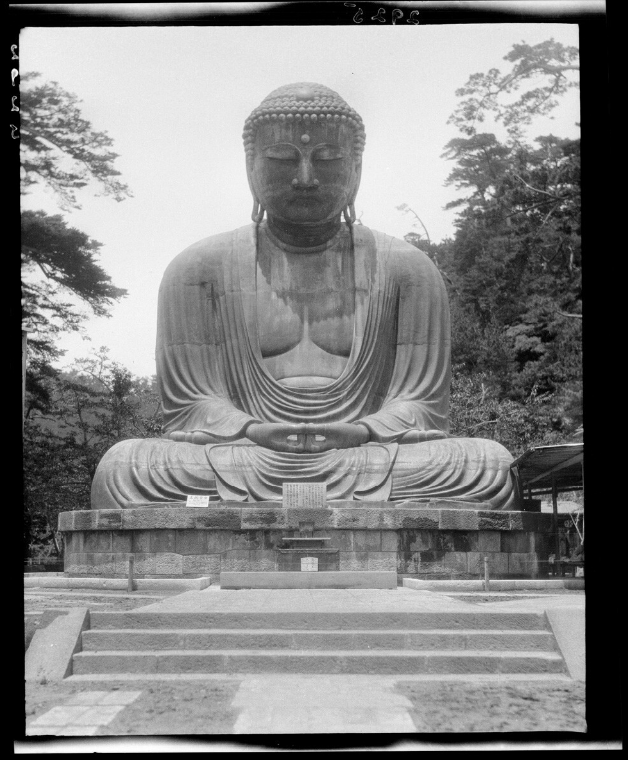
- Date: 1925
- Information: Amateur American photographer Sidney Gamble (1890-1968) visited Asia on four occasions between 1908 and 1932. This photograph is from his 1925 trip to Japan.
- Description: Landscape curbing has been added to both sides of the statue foundation, with what appears to be paving stones going around the statue. Roped stakes are also driven into the ground by the curbing, prohibiting closer access to the statue. A low, shin-height slab has been placed in front of the coin box (possibly for kneeling?). A small, low table with a round incense burner is placed between the coin box and foundation. Three small wooden placards are also visible. The large placard in the center possibly describes the damage to the Daibutsu during the Great Kantō earthquake (as seen in another photograph in the Archive). Additionally, in later photographs, a small placard is placed on top of the table giving the height dimension of the Daibutsu: “forty-two feet, five inches” (approximately 12.9 meters)[大佛身像總高ニ四十二尺五寸周圓十六間一尺重量二萬五十].
Sequential Chronology: 37
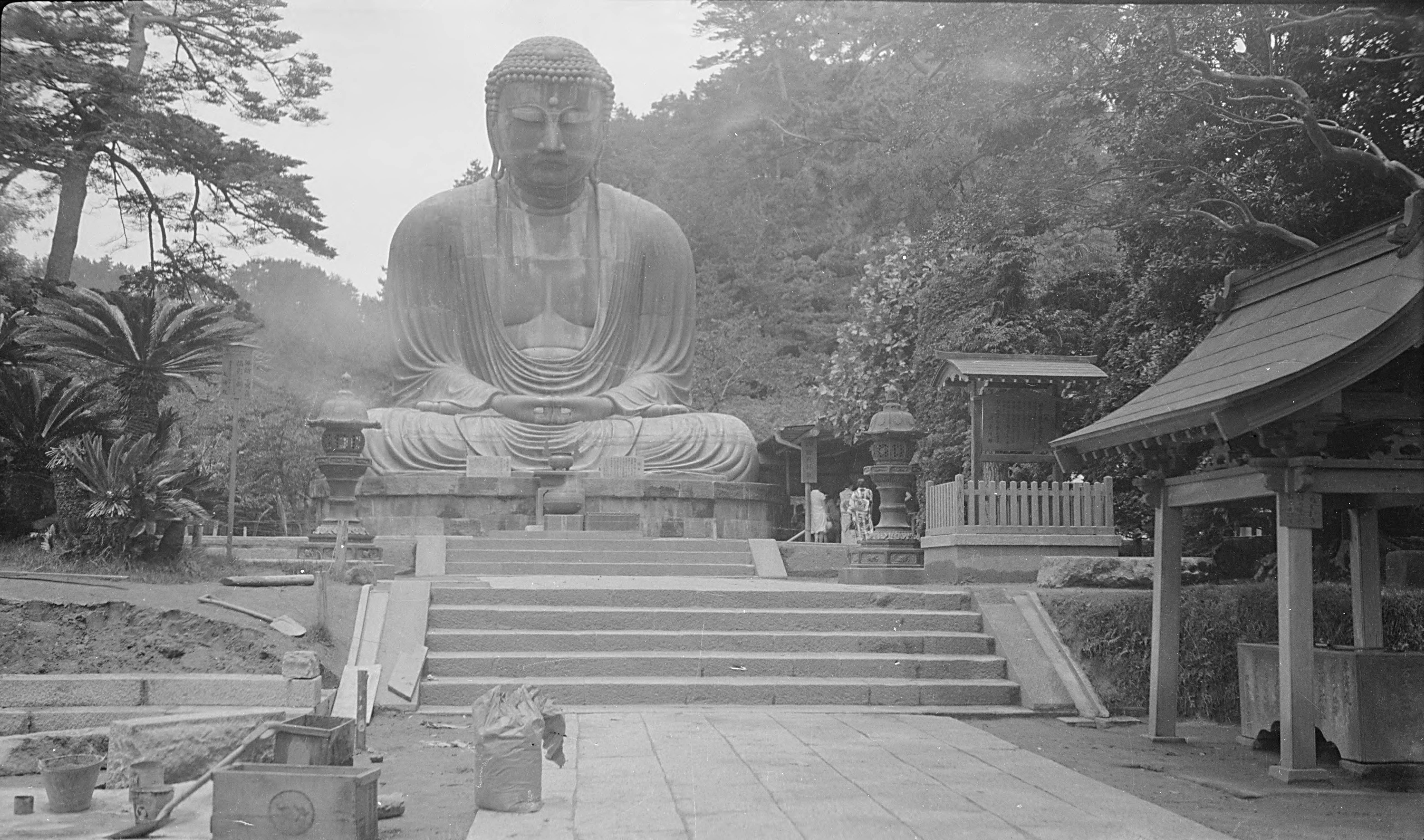
- Date: 1935
- Information: Amateur American photographer Mary Jo Read took this photograph on a trip to East Asia in 1935.
- Description: The erosion next to the stairs is in the process of being fixed. The altar area now displays a taller table, on top of which the original incense bowl has been placed. A larger round urn has also been placed in front of the altar table, replacing the coin offering box, which now appears positioned on the right side. (Judging by a dated postcard in the Archive, this arrangement was in place by at least January 1931). Based on another photograph in the Archive, the left-hand sign atop the pedestal is bilingual describing the dimensions of the Daibutsu; the placard on the right describes the damage during the 1923 earthquake.
Sequential Chronology: 38

- Date: 1945
- Information: Photograph from William Galen Harrach, who served during World War II; part of the Digital Collections of the National WWII Museum.
- Description: The general altar arrangement has remained the same since the mid-1930s, but the censer on the altar has been traded out for one that is missing the “wings” seen on the original. The large round urn in front of the altar table has also changed. Both signs on the pedestal appear to have remained the same for the past decade.
Hello Peter,
Thank you for this wonderfully informative piece on the Kamakura Daibutsu.
I am fortunate to have a bronze cast copy of the Daibutsu as the focus in my studio/meditation room. It is inscribed with the date it was made, the sculptor and the casting sculptor and that it is a copy of the Daibutsu. Taisho year 14. May (1925). Shinkai Takezo sculptor (nephew of Shinkai Taketaro), Bronze casting by Abe Insai. It sits about 400mm high. It does not have a base but sits on wood and I would like to create a base for it modelled on the original’s one of which I understand only four of 32 petals remain.
I note in images before no: 09 in your chronology, incomplete view of the petals but wonder if in your work you have come across any which are more complete which will allow me to make an accurate copy of their style worthy of the piece. Also whether you know where the petals would have been arranged. The images show them placed at a lower level below his seat except for image no: 09 which has them where I would have expected them to be, directly around the base he sits on. Would they have been side by side or overlapping and so on?
Any help would be much appreciated .
Kind Regards
Richard Hamilton
Christchurch
New Zealand
LikeLike
Hi Richard,
What a wonderful project. The four petals are on display behind the statue today. If you do an image search online for “鎌倉大仏蓮弁” or “鎌倉大仏4枚の蓮弁” [Kamakura Daibutsu [(4) lotus petals] you will immediately find several photos. [e.g. https://www.google.com/search?q=%E9%8E%8C%E5%80%89%E5%A4%A7%E4%BB%8F4%E6%9E%9A%E3%81%AE%E8%93%AE%E5%BC%81&client=firefox-b-1-e&source=lnms&tbm=isch&sa=X&ved=2ahUKEwj12fHL4KbwAhUxHzQIHXV3CdMQ_AUoAXoECAEQAw&biw=2111&bih=1052#imgrc=K7130ulzIY2VkM%5D
I think if you dig around long enough you may find something for your needs. I know of no old photos which depict them any more clearly than modern tourist photography. I looked quickly through several reconstruction/preservation reports (there was a big project in 1961 and another more recently), but I found no schematics for the petals, unfortunately, only the statue.
According to the 1961 preservation report, the petals were cast in 1735, but the caster only produced a total of four. It seems there was interest in completing the project in the ensuing decades, but it never came to fruition. The four petals just floated around the pedestal since then it seems.
A “lotus throne” is a very common element to Buddhist iconography, so you could certainly still make a faithful “replica” of a lotus throne for your Daibutsu. The Kōtoku-in Temple website contain several older drawings of the Kamakura Daibutsu as envisioned by Japanese artists, and they almost always clearly depict a lotus throne (honestly, it would almost be inconceivable to not depict a Buddha on a throne for traditional artists). Scroll to the bottom here: https://www.kotoku-in.jp/history.html.
If you want to see an example of a larger Japanese Buddhist statue with the lotus petals around the base, you can look here: https://peterromaskiewicz.com/2020/08/27/sakaeyas-real-photo-postcard-of-shinkoji/
Hope this gives you some leads, Cheers!
LikeLike
Hi Peter, Thank you very much for our reply, I will certainly check out the sites you suggest, they will be of great help.
It would be a proper thing to put him on a suitable base since I’m sure the figure was made with right intentions.
Again, many thanks.
Regards,
Richard
LikeLike